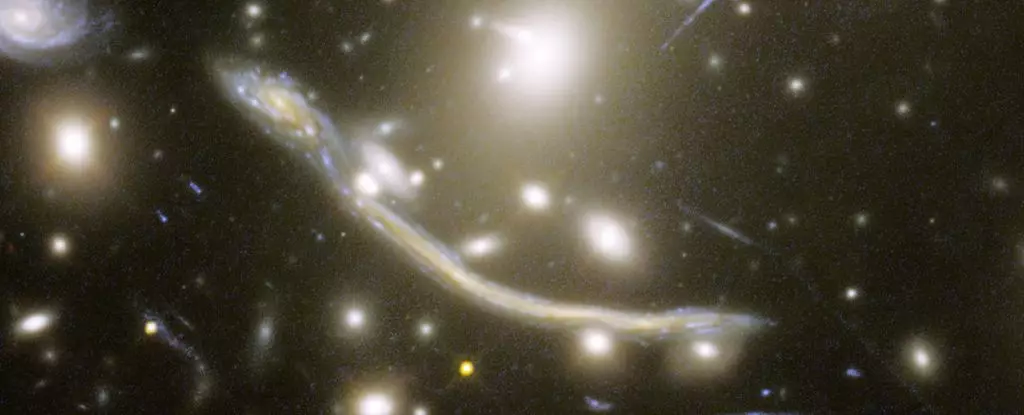The realm of astrophysics is constantly pushing the boundaries of human knowledge, particularly when it comes to understanding the early Universe. Traditionally, observing the faint light of distant galaxies posed significant challenges due to the immense distances and the limitations of older telescopes. However, the advent of the James Webb Space Telescope (JWST) has marked a pivotal moment in astronomical research. By successfully resolving over 40 individual stars within a galaxy whose light has traveled nearly 6.5 billion years to reach Earth, astronomers have opened new doors to understanding the cosmos.
As noted by astrophysicist Fengwu Sun from the University of Arizona, this achievement heralds a new era in our ability to study distant galaxies. While the Hubble Space Telescope paved the way with previous observations of about seven stars in similar contexts, the JWST’s capabilities empower researchers to explore larger numbers of individual stars, thus broadening our understanding of complex astronomical phenomena such as dark matter. This capability allows researchers to delve deeper into the fundamental structures of galaxies and the nature of stellar evolution.
A significant portion of this groundbreaking work relies on the principles of gravitational lensing, a fascinating consequence of Einstein’s theory of general relativity. As light traverses the warped fabric of space-time near massive cosmic structures, such as galaxy clusters, it can become distorted and magnified. This phenomenon is comparable to observing objects through a trampoline that bends and stretches under a weighted mass.
One particularly striking example of gravitational lensing is the Dragon Arc—a luminous stretch across the night sky that appears to form a dragon shape. This unique formation consists of distinct images of a distant spiral galaxy, manipulatively arranged into what seems like an ethereal creature. This optical illusion results from the gravitational influence of a massive cluster known as Abell 370, located approximately 4 billion light-years from Earth.
Astronomers have mastered the techniques necessary to reverse-engineer the effects of gravitational lensing. By untangling the distorted light, they can reconstruct images of these distant galaxies, providing insightful perspectives on their structure and composition, including the added advantage of amplified brightness.
In addition to the broader effects of gravitational lensing, a more intricate phenomenon known as microlensing comes into play. Between the clustered galaxies of Abell 370, individual stars drift through the void, contributing their own lensing effects to the overall light we perceive from distant astronomical sources. This phenomenon allows astronomers to discern individual stars that would otherwise remain invisible due to their faintness.
A team led by Yoshinobu Fudamoto from Chiba University capitalized on this microlensing effect in their quest to identify a background galaxy magnified by the gravitational influences of Abell 370. Unexpectedly, they discovered 44 individual stars within the Dragon Arc’s smeared light, a remarkable finding that underscored the JWST’s advanced capabilities. This narrative illustrates how the quest for knowledge can lead to unexpected discoveries, expanding our understanding of the Universe in unforeseen ways.
The newfound abundance of stars in the Dragon Arc offers a remarkable opportunity to study stellar evolution at significant distances. Many of these stars are identified as red supergiants—massive stars nearing the end of their lifecycles. Unlike their hotter counterparts, which predominantly characterize previous observations, red supergiants are relatively cooler and exhibit a reddish hue. Their more subdued brightness has historically made them harder to detect, especially across astronomical distances.
The JWST’s ability to perceive red wavelengths has proven invaluable in identifying these stellar giants, thereby enriching our knowledge of galaxy evolution. Understanding the life cycles of red supergiants can provide insights into the processes governing star formation and the dynamics of galaxies far beyond our own.
As the JWST continues its mission, expectations mount for further discoveries hidden within the intricate light patterns of distant galaxies. With each observation, astronomers inch closer to uncovering the secrets of the Universe, enhancing our grasp of cosmic processes and structures. The ability to view more stars—particularly those that have eluded detection until now—promises to yield insights that could redefine our understanding of dark matter and the evolution of galaxies.
The JWST’s groundbreaking discoveries not only exemplify the triumph of technological advancements in astronomy but also ignite the curiosity that propels humanity to explore the vast mysteries of the universe. As we stand on the brink of new revelations, one can only imagine the rich tapestry of knowledge yet to be woven from the stars.


Leave a Reply